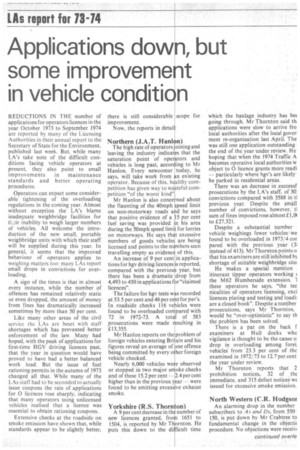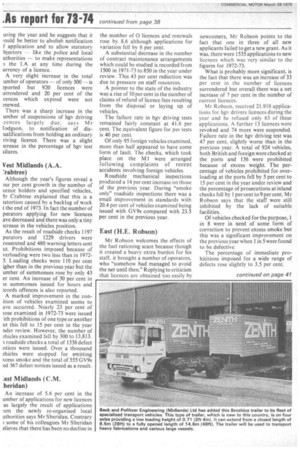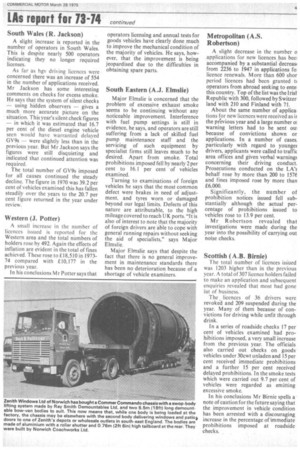Applications dow n, but some improvement in vehicle conditidn
Page 39

Page 40

Page 43

If you've noticed an error in this article please click here to report it so we can fix it.
REDUCTIONS IN THE number of applications for operators licences in the year October 1973 to September 1974 are reported by many of the Licensing Authorities in their annual report to the Secretary of State for the Environment, published last week. But, while many LA's take note of the difficult conditions facing vehicle operators at present, they also point to small improvements in maintenance standards and better operating procedures.
Operators can expect some considerable tightening of the overloading regulations in the coming year. Almost without exception the LA's blame inadequate weighbridge facilities •for inability to weigh larger numbers of vehicles. All welcome the introduction of the new small, portable weighbridge units with which their staff will be supplied during this year. In general, it seems that the improved behaviour of operators applies to weighing matters too: many LAs report small drops in convictions for overloading.
A sign of the times is that in almost every instance, while the number of offences has remained relatively static or even dropped, the amount of money from fines has dramatically increased sometimes by more than 50 per cent.
Like many other areas of the civil service the LAs are beset with staff shortages which has prevented better enforcement of the law. Many had hoped, with the peak of applications for first-time HGV driving licences past, that the year in question would have proved to have had a better balanced work load. But the issue of fuel rationing permits in the autumn of 1973 changed all that. While many of the LAs staff had to be seconded to actually issue coupons the rate of applications for 0 licences rose sharply, indicating that many operators using unlicensed vehicles realised that a licence was essential to obtain rationing coupons.
Extensive checks at the roadside on smoke emission have shown that, while standards appear to be slightly better, there is still considerable scope for improvement.
Now, the reports in detai :
Northern (J.A.T. Han' n)
The high rate of operators joining and leaving the industry indicates that the saturation point of operators and vehicles is long past, according to Mr Hanlon. Every newcomer today, he says, will take work from n existing operator. Because of this, h althy competition has given way to wa teful competition "of the worst kind" Mr Hanlon is also conce ned about the flaunting of the 40mph speed limit on non-motorway roads and he says that positive evidence of a 15 per cent fuel saving was provided n his area during the 50mph speed limit for lorries on motorways. He says tht excessive numbers of goods vehicles are being licensed and points to the ntim hers seen travelling empty as evidence of this.
An increase of 9 per cent in applications for hgv driving licences 's reported, compared with the previou year, but there has been a dramatic drop from 4,493 to 450 in applications f r "claimed licences".
The failure for hgv tests w s recorded at 53.5 per cent and 46 per cent for psv's. In roadside checks 116 vehicles were found to be overloaded compared with 72 in 1972-73. A total of 583 prosecutions were made tesulting in £13,355.
Mr Hanlon reports on the problem of foreign vehicles entering Britain and his figures reveal an average of pne offence being committed by every other foreign vehicle checked.
Nearly 6,000 vehicles weite observed or stopped in two major s oke checks and of these 15.2 per cent — 2.4 per cent higher than in the previous year -were found to be emitting excessive exhaust smoke.
Yorkshire (RS. Thorn on)
A 9 per cent decrease in th number of new licences granted, froti 1651 to 1504, is reported by Mr Thornton. He puts this down to the di ficult time
which the haulage industry has bee going through. Mr Thornton said th. applications were slow to arrive fro local authorities after the local gover. ment re-organisation last April. The was still one application outstanding the end of the year under review. He hoping that when the 1974 Traffic A becomes operative local authorities w object to 0 licence grants more readi — particularly where hgv's are likely be parked in residential areas.
There was an decrease in successf prosecutions by the LA's staff, of 30: convictions compared with 3588 in tl previous year. Despite the small number of convictions, however, t: sum of fines imposed rose almost £ 1,01 to £27,321.
Despite a substantial number vehicle weighings fewer vehicles we found to be overloaded in 1973/4 cor pared with the previous year (3: instead of 413). Mr Thornton points o that his examiners are still inhibited b3 shortage of suitable weighbridge site:
He makes a special mention itinerant tipper operators working the M62 Humberside extension. 1 these operators he says, "the tec nicalities of operators licensing, exci licences plating and testing and loadil are a closed book". Despite a number prosecutions, says Mr Thornton, would be "over-optimistic" to say th the problem has been solved.
There is a pat on the back f examiners at Hull docks whc vigilance is thought to be the cause o: drop in overloading among forei, vehicles from 23.3 per cent of thc examined in 1972/ 73 to 12.7 per cent the year under review.
Mr Thornton reports that 2 prohibition notices, 32 of the immediate. and 315 defect notices we issued for excessive smoke emission.
North Western (C.R. Hodgsor
An alarming drop in the number subscribers to As and Ds, from 550 150. is put down by Mr Crabtree to fundamental change in the objectic procedure. No objections were receivi
uring the year and he suggests that it /could be better to abolish notification f application and to allow statutory bjectors like the police and local uthorities — to make representations 3 the LA at any time during the urrency of a licence.
A very slight increase in the total umber of operators — of only 300 — is :ported but 920 licences were arrendered and 20 per cent of the cences which expired were not :newed.
There was a sharp increase in the umber of suspensions of hgv driving cences largely due. says Mr 1odgson, to notification of disualifications from holding an ordinary riving licence, There was a slight icrease in the percentage of hgv test tilures.
Vest Midlands (A.A. 7rabtree)
Although the year's figures reveal a )ur per cent growth in the number of cence holders and specified vehicles, 1r Crabtree explained that this is a istortion caused by a backlog of work t the end of 1973. In fact the number of perators applying for new licences ave decreased and there was only a tiny icrease in the vehicles position.
As the result of roadside checks 1197 perators and 1229 drivers were rosecuted and 480 warning letters sent ut. Prohibitions imposed because of verloading were two less than in 19723. Loading checks were 110 per cent igher than in the previous year but the umber of summonses rose by only 43 er cent. An increase of 30 per cent in K summonses issued for hours and :cords offences is also reported.
A marked improvement in the conition of vehicles examined seems to ave occurred. Nearly 23 per cent of lose examined in 1972-73 were issued ith prohibitions of one type or another ut this fell to 15 per cent in the year nder review. However, the number of :hicles examined fell by 300 to 13,813. 1 roadside checks a total of 1338 defect otices were issued. Over a thousand :hicles were stopped for emitting KCCSS smoke and the total of 555 GV9s rid 367 defect notices issued as a result.
,ast Midlands (C.M. heridan)
An increase of 5.6 per cent in the umber of applications for new licences as largely the result of applications .om the newly re-organised local uthorities says Mr Sheridan. Contrary ) some of his colleagues Mr Sheridan el ieves that there has been no decline in
the number of 0 licences and renewals rose by 8.6 although applications for variation fell by 6 per cent.
A substantial decrease in the number of contract maintenance arrangements which could be studied is recorded from 1500 in 1971-73 to 850 in the year under review. This 43 per cent reduction was due to pressure on staff resources.
A pointer to the state of the industry was a rise of 10 per cent in the number of claims of refund of licence fees resulting from the disposal or laying up of vehicles.
The failure rate in hgv driving tests remained fairly constant at 41.6 per cent. The equivalent figure for psv tests is 40 per cent.
Of only 95 foreign vehicles examined, more than half appeared to have some form of fault. The checks, which took place on the M I were arranged following complaints of recent accidents involving foreign vehicles.
Roadside mechanical inspections produced a 14 per cent increase on those of the previous year. During "smoke only" roadside inspections there was a small improvement in standards with 20.4 per cent of vehicles examined being issued with GV9s compared with 23.5 per cent in the previous year.
East (RE. Robson)
Mr Robson welcomes the effects of the fuel rationing scare because though it created a heavy extra burden for his staff, it brought a number of operators, who "somehow had managed to avoid the net until then." Replying to criticism that licences arc obtained too easily by newcomers, Mr Robson points to the fact that one in three of all new applicants failed to get a new grant. As it was, there were 1535 applications to new licences which was very similar to the figures for 1972-73.
What is probably more significant, is the fact that there was an increase of 33 per cent in the number of licences surrendered but overall there was a net increase of 7 per cent in the number of current licences.
Mr Robson, received 21.918 applications for hgv drivers licences during the year and he refused only 63 of these applications. A further 13 licences were revoked and .74 more were suspended. Failure rate in the hgv driving test was 47 per cent, slightly worse than in the previous year. A total of 924 vehicles, both British and foreign were checked at the ports and 136 were prohibited because of excess weight. The percentage of vehicles prohibited for overloading at the ports fell by 5 per cent to 15 per cent in the year under review and the percentage of prosecutions at inland checks fell by 1 per cent to 9 per cent, Mr Robson says that the staff were still inhibited by the lack of suitable facilities.
Of vehicles checked for the purpose, 1 in 8 were in need of some form of correction to prevent excess smoke but this was a significant improvement on the previous year when 1 in 5 were found to be defective.
The percentage of immediate prohititions imposed for a wide range of defects rose slightly to 3.5 per cent.
South Wales (R. Jackson)
A slight increase is reported in the number of operators in South Wales. This is despite nearly 500 operators indicating they no longer required licenses.
As far as hgv driving licences were concerned there was an increase of 554 in the number of applications received. Mr Jackson has some interesting comments on checks for excess smoke. He says that the system of silent checks — using hidden observers — gives a much more accurate picture on the situation. This year's silent check figures — in which it was estimated that 16.7 per cent of the diesel engine vehicle seen would have warranted delayed GV9s — were slightly less than in the previous year. But Mr Jackson says the figures were still disquieting and indicated that continued attention was required.
The total number of GV9s imposed for all causes continued the steady decline. The figure in 1970 was 39.2 per cent of vehicles examined this has fallen steadily over the years to the 20.7 per cent figure returned in the year under review.
Western (J. Potter)
A small increase in the number of licences issued is reported for the Western area and the total numbers of holders rose by 492. Again the effects of inflation are evident in the total of fines achieved. These rose to £18,510 in 197374 compared with £10,177 in the previous year.
In his conclusions Mr Potter says that operators licensing and annual tests for goods vehicles have clearly done much to improve the mechanical condition of the majority of vehicles. He says, however, that the improvement is being jeopardised due to the difficulties in obtaining spare parts.
South Eastern (A.J. Elmslie)
Major Elmslie is concerned that the problem of excessive exhaust smoke seems to be continuing without any noticeable improvement. Interference with fuel pump settings is still in evidence, he says, and operators are still suffering from a lack of skilled fuel pump maintenance staff and the servicing of such equipment by specialist firms still leaves much to be desired. Apart from smoke. Total prohibitions imposed fell by nearly 2 per cent to 16.1 per cent of vehicles examined.
Turning to examinations of foreign vehicles he says that the most common defect were brakes in need of adjustment, and tyres worn or damaged beyond our legal limits. Defects of this nature are attributable, to the high mileage covered to reach UK ports. "It is also of interest to note that the majority of foreign drivers are able to cope with general running repairs without seeking the aid of specialists," says Major Elmslie.
Major Elmslie says that despite the fact that there is no general improvement in maintenance standards there has been no deterioration because of a shortage of vehicle examiners.
Metropolitan (AS. Robertson)
A slight decrease in the number o applications for new licences has beei accompanied by a substantial decreas, from 2236 to 1947 in applications fo licence renewals. More than 600 shor period licences had been granted t( operators from abroad seeking to ente; this country. Top of the list was the 'risk Republic with 300, followed by Switzer• land with 210 and Finland with 71.
About the same number of applica. tions for new licences were received as it the previous year and a large number oi warning letters had to be sent oui because of convictions shown or applications. In a number of cases. particularly with regard to younget drivers, applicants were called to traffic area offices and given verbal warnings concerning their driving conduct. Prosecutions conducted on the LA's behalf rose by more than 200 to 1576 and fines imposed rose by more than £6,000.
Significantly, the number of prohibition notices issued fell substantially although the actual percentage of prohibitions issued to vehicles rose to 13.9 per cent.
Mr Robertson revealed that investigations were made during the year into the possibility of carrying out noise checks.
Scottish ( A.B. Birnie)
The total number of licences issued was 1203 higher than in the previous year. A total of 307 licence holders failed to make an application and subsequent enquiries revealed that most had gone jut of business.
The, licences of 36 drivers were revoked and 209 suspended during the year. Many of them because of convictions for driving while unfit through drink.
In a series of roadside checks 17 per cent of vehicles examined had prohibitions imposed, a very small increase from the previous year. The officials also carried out checks on goods vehicles under 30cwt unladen and 15 per cent received immediate prohibitions and a further 15 per cent received delayed prohibitions. In the smoke tests which were carried out 9.7 per cent of vehicles were regarded as emitting excessive smoke.
In his conclusions Mr Birnie spells a note of caution for the future saying that the improvement in vehicle condition has been arrested with a discouraging increase in the percentage of 'immediate prohibitions imposed at roadside checks.




























































































